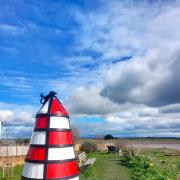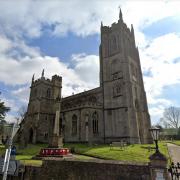There’s more splendour to Cheddar Gorge than immediately meets the eye

Standing in the sunshine on the path high above Cheddar Gorge the world feels an expansive and airy place. On a clear day the landscape is vast, dramatic and beautiful, but there is also astonishing beauty buried in a twilight world deep, deep below.
Hidden in the maw of earth, where the River Yeo flows through Britain’s largest underground river system, are awesome (in the true sense) caverns of stalactites and stalagmites, reflective pools, mysterious shapes and shadows…. and some surprising human remains that have lain hidden for more than 14,000 years.
During the 19th century the caves of Cheddar Gorge were growing in popularity as a tourist destination at a time when George Cox and his nephew, Richard Cox Gough, both operated show caves there.
Since 1877 Gough had been proprietor of a cave that subsequently became known as Gough’s Old Cave, whose entrance was situated slightly above road level to the west of today’s Gough’s Cave. But he hoped to find something better and in 1890 he started to excavate more deeply into one of his other caves, the accessible front part of which had been used to store carts. By early 1892 he realised he was on to a good thing; millennia-old geological opulence began to be revealed. Gough continued his labours for much of the rest of the decade, opening up successive areas of the cave. In 1898 the Weston-super-Mare Gazette described Gough’s Cave as a ‘Temple of Magnificence’ and in 1899 splendours that had previously only been visible by candlelight, and latterly gaslights, were illuminated by electricity. Gough’s Cave was firmly on the Victorian tourist map.

Commercial rivalry between Gough and Cox was keen; in 1902 it was said that the only point of agreement between them was the entrance fee to each cave of one shilling (five pence).
Gough died in 1902 and his wife and eldest son continued to run the business. Then, in 1903, his cave achieved a significant advantage over Cox’s. During the course of improving drainage, flooding being a disruptive problem in the cave, a complete human skeleton was discovered.
People flocked to see these remains. Dubbed ‘Cheddar Man’, DNA extracted from his teeth, along with other tests, has subsequently revealed him to be the ancestor of people still living in the area. He is Mesolithic, his precise age is variably reported – he’s roughly 10,000 years old – and he’s the oldest complete human skeleton ever found in Britain. The original skeleton is stored in a vault in London’s Natural History Museum – what lies in Gough’s cave today is a very convincing replica.
But more surprises were in store. Other human and animal bones had been discovered during the 19th century and later, but it wasn’t until the 1980 and 1990s, when further excavation and more sophisticated analysis such as radiocarbon dating could be undertaken, that the importance of many of the finds was realised.
The accrued evidence of successive excavations showed that for a time, towards the end of the last Ice Age, people used Gough’s Cave for seasonal shelter. And behind them, buried in accumulated silt and gravel, they left some startling insights into the lives they led.
Human and animal bones had been treated in the same way, the resultant debris being left together on the ground. As more and more of the cave’s ancient secrets were discovered it became increasingly apparent that ‘nutritional’ cannibalism had been practised.
In addition to this, fragments of human skulls were pieced back together and closely examined. This revealed, rather shockingly, that the skulls had been removed from their bodies soon after death. The soft tissue had been skillfully removed and the skulls intricately fashioned into drinking vessels, or skull cups. They have been dated to around 14,700 years old, the oldest known examples of skull cups in the world.
Much is still to be learned but it seems that our Cheddar ancestors were, physically, modern people like us, of fairly complex behavior, but they lived as skilled hunter-gatherers with cannibalistic and ritualistic inclinations. But all this was unknown to Gough and his family.
In 1927 the lease on the cave expired and the Longleat Estate took control, with Gough’s son continuing to run it until 1933.
Today, it is a big commercial enterprise but this doesn’t detract from the astonishing grandeur that awaits as you proceed deeper and deeper into this subterranean cathedral. Breathtakingly beautiful pools lie quietly; ‘frozen’ cascades of astonishing colour carry the eye up into shadows.
And, more mundanely but quite deliciously, there is cheese. Cheddar cheese has been produced in the area for centuries and it is still matured in the caves – great stacks of it, sitting underground in ideal humidity and temperature for up to a year before being sold in the local shops. The genuine article.
The Cheddar Caves are an astonishing world of beauty and butchery. Out of the daylight and into the dimness through low-lit ways they draw you…. into the mysterious dark-hushed haunts of ancient peoples. So like us, yet so different.
Some bones to chew over:
The formation of Gough’s Cave probably started around 500,000 years ago when water began to dissolve the limestone rock.
Animal remains found in the cave include those of wild horses, red deer, wolves, lynx and bears. These animals, amongst others, inhabited the region towards the end of the last Ice Age.
Other artifacts found in Gough’s Cave include flint tools plus carved mammoth ivory and reindeer antlers. These latter are likely to have been imported from elsewhere.
In November 1892 Gough had excavated sufficiently far in to the cave to hold a concert there. It was reported that 600 people attended.



























